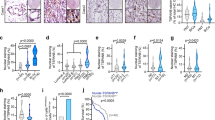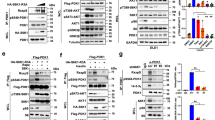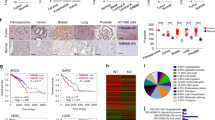Abstract
Mounting evidence has shown that the insulin-like growth factor-1 receptor (IGF-1R) has critical roles in cancer cell growth. This has prompted pharmacological companies to develop agents targeting the receptor. Surprisingly, clinical trials using specific IGF-1R antibodies have, however, revealed disappointing results. Further understanding of the role of IGF-1R in cancer cells is therefore necessary for development of efficient therapeutic strategies. Recently, we showed that IGF-1R is sumoylated and translocated into the cell nucleus where it activates gene transcription. Several other studies have confirmed our findings and it has been reported that nuclear IGF-1R (nIGF-1R) has prognostic and predictive impact in cancer. To increase the understanding of IGF-1R in cancer cells, we here present the first study that proposes a pathway by which IGF-1R translocates into the cell nucleus. We could demonstrate that IGF-1R first associates with the dynactin subunit p150Glued, which transports the receptor to the nuclear pore complex, where it co-localizes with importin-β followed by association with RanBP2. Sumoylation of IGF-1R seems to be required for interaction with RanBP2, which in turn may serve as the SUMO E3 ligase. In the context of sumoylation, we provided evidence that it may favor nIGF-1R accumulation by increasing the stability of the receptor. Taken together, topographic and functional interactions between dynactin, importin-β and RanBP2 are involved in nuclear translocation of IGF-1R. Our results provide new understanding of IGF-1R in cancer, which in turn may contribute to development of new therapeutic strategies.
This is a preview of subscription content, access via your institution
Access options
Subscribe to this journal
Receive 50 print issues and online access
$259.00 per year
only $5.18 per issue
Buy this article
- Purchase on Springer Link
- Instant access to full article PDF
Prices may be subject to local taxes which are calculated during checkout







Similar content being viewed by others
Change history
08 December 2022
A Correction to this paper has been published: https://doi.org/10.1038/s41388-022-02523-3
References
Baserga R . The insulin-like growth factor I receptor: a key to tumor growth? Cancer Res 1995; 55: 249–252.
LeRoith D, Werner H, Beitner-Johnson D, Roberts CT Jr . Molecular and cellular aspects of the insulin-like growth factor I receptor. Endocr Rev 1995; 16: 143–163.
Yu H, Rohan T . Role of the insulin-like growth factor family in cancer development and progression. J Natl Cancer Inst 2000; 92: 1472–1489.
Resnicoff M, Tjuvajev J, Rotman HL, Abraham D, Curtis M, Aiken R et al. Regression of C6 rat brain tumors by cells expressing an antisense insulin-like growth factor I receptor RNA. J Exp Ther Oncol 1996; 1: 385–389.
Pollak M . The insulin and insulin-like growth factor receptor family in neoplasia: an update. Nat Rev Cancer 2012; 12: 159–169.
Baserga R . The decline and fall of the IGF-I receptor. J Cell Physiol 2013; 228: 675–679.
Sehat B, Tofigh A, Lin Y, Trocme E, Liljedahl U, Lagergren J et al. SUMOylation mediates the nuclear translocation and signaling of the IGF-1 receptor. Sci Signal 2010; 3: ra10.
Aleksic T, Chitnis MM, Perestenko OV, Gao S, Thomas PH, Turner GD et al. Type 1 insulin-like growth factor receptor translocates to the nucleus of human tumor cells. Cancer Res. 2010; 70: 6412–6419.
Deng H, Lin Y, Badin M, Vasilcanu D, Stromberg T, Jernberg-Wiklund H et al. Over-accumulation of nuclear IGF-1 receptor in tumor cells requires elevated expression of the receptor and the SUMO-conjugating enzyme Ubc9. Biochem Biophys Res Commun 2011; 404: 667–671.
Warsito D, Sjostrom S, Andersson S, Larsson O, Sehat B . Nuclear IGF1R is a transcriptional co-activator of LEF1/TCF. EMBO Rep 2012; 13: 244–250.
Asmane I, Watkin E, Alberti L, Duc A, Marec-Berard P, Ray-Coquard I et al. Insulin-like growth factor type 1 receptor (IGF-1R) exclusive nuclear staining: a predictive biomarker for IGF-1R monoclonal antibody (Ab) therapy in sarcomas. Eur J Cancer 2012; 48: 3027–3035.
Sarfstein R, Pasmanik-Chor M, Yeheskel A, Edry L, Shomron N, Warman N et al. Insulin-like growth factor-I receptor (IGF-IR) translocates to nucleus and autoregulates IGF-IR gene expression in breast cancer cells. J Biol Chem 2012; 287: 2766–2776.
Ibarra C, Vicencio JM, Estrada M, Lin Y, Rocco P, Rebellato P et al. Local control of nuclear calcium signaling in cardiac myocytes by perinuclear microdomains of sarcolemmal insulin-like growth factor 1 receptors. Circ Res 2013; 112: 236–245.
Wu YC, Zhu M, Robertson DM . Novel nuclear localization and potential function of insulin-like growth factor-1 receptor/insulin receptor hybrid in corneal epithelial cells. PLoS ONE 2012; 7: e42483.
van Gaal JC, Roeffen MH, Flucke UE, van der Laak JA, van der Heijden G, de Bont ES et al. Simultaneous targeting of insulin-like growth factor-1 receptor and anaplastic lymphoma kinase in embryonal and alveolar rhabdomyosarcoma: A rational choice. Eur J Cancer 2013; 49: 3462–3470.
Gruenberg J, Griffiths G, Howell KE . Characterization of the early endosome and putative endocytic carrier vesicles in vivo and with an assay of vesicle fusion in vitro. J Cell Biol 1989; 108: 1301–1316.
Schroer TA, Sheetz MP . Two activators of microtubule-based vesicle transport. J Cell Biol 1991; 115: 1309–1318.
Gill SR, Schroer TA, Szilak I, Steuer ER, Sheetz MP, Cleveland DW . Dynactin, a conserved, ubiquitously expressed component of an activator of vesicle motility mediated by cytoplasmic dynein. J Cell Biol 1991; 115: 1639–1650.
Schroer TA . Dynactin. Annu Rev Cell Dev Biol 2004; 20: 759–779.
Quintyne NJ, Gill SR, Eckley DM, Crego CL, Compton DA, Schroer TA . Dynactin is required for microtubule anchoring at centrosomes. J Cell Biol 1999; 147: 321–334.
Waterman-Storer CM, Karki S, Holzbaur EL . The p150Glued component of the dynactin complex binds to both microtubules and the actin-related protein centractin (Arp-1). Proc Natl Acad Sci USA 1995; 92: 1634–1638.
Strom AC, Weis K . Importin-beta-like nuclear transport receptors. Genome Biol 2001; 2: REVIEWS3008.
Yokoyama N, Hayashi N, Seki T, Pante N, Ohba T, Nishii K et al. A giant nucleopore protein that binds Ran/TC4. Nature 1995; 376: 184–188.
Ben-Efraim I, Gerace L . Gradient of increasing affinity of importin beta for nucleoporins along the pathway of nuclear import. J Cell Biol 2001; 152: 411–417.
Pichler A, Gast A, Seeler JS, Dejean A, Melchior F . The nucleoporin RanBP2 has SUMO1 E3 ligase activity. Cell 2002; 108: 109–120.
Soderberg O, Gullberg M, Jarvius M, Ridderstrale K, Leuchowius KJ, Jarvius J et al. Direct observation of individual endogenous protein complexes in situ by proximity ligation. Nat Methods 2006; 3: 995–1000.
Mu FT, Callaghan JM, Steele-Mortimer O, Stenmark H, Parton RG, Campbell PL et al. EEA1, an early endosome-associated protein. EEA1 is a conserved alpha-helical peripheral membrane protein flanked by cysteine ‘fingers’ and contains a calmodulin-binding IQ motif. J Biol Chem 1995; 270: 13503–13511.
Dumas JJ, Merithew E, Sudharshan E, Rajamani D, Hayes S, Lawe D et al. Multivalent endosome targeting by homodimeric EEA1. Mol Cell 2001; 8: 947–958.
Skoufias DA, Wilson L . Mechanism of inhibition of microtubule polymerization by colchicine: inhibitory potencies of unliganded colchicine and tubulin-colchicine complexes. Biochemistry 1992; 31: 738–746.
Deacon SW, Serpinskaya AS, Vaughan PS, Lopez Fanarraga M, Vernos I, Vaughan KT et al. Dynactin is required for bidirectional organelle transport. J Cell Biol 2003; 160: 297–301.
Flores-Rodriguez N, Rogers SS, Kenwright DA, Waigh TA, Woodman PG, Allan VJ . Roles of dynein and dynactin in early endosome dynamics revealed using automated tracking and global analysis. PLoS ONE 2011; 6: e24479.
Yeh TY, Quintyne NJ, Scipioni BR, Eckley DM, Schroer TA . Dynactin's pointed-end complex is a cargo-targeting module. Mol Biol Cell 2012; 23: 3827–3837.
Shrum CK, DeFrancisco D, Meffert MK . Stimulated nuclear translocation of NF-κB and shuttling differentially depend on dynein and the dynactin complex. Proc Natl Acad Sci USA 2009; 106: 2647–2652.
Lo HW, Ali-Seyed M, Wu Y, Bartholomeusz G, Hsu SC, Hung MC . Nuclear-cytoplasmic transport of EGFR involves receptor endocytosis, importin beta1 and CRM1. J Cell Biochem 2006; 98: 1570–1583.
Giri DK, Ali-Seyed M, Li LY, Lee DF, Ling P, Bartholomeusz G et al. Endosomal transport of ErbB-2: mechanism for nuclear entry of the cell surface receptor. Mol Cell Biol 2005; 25: 11005–11018.
Kazgan N, Williams T, Forsberg LJ, Brenman JE . Identification of a nuclear export signal in the catalytic subunit of AMP-activated protein kinase. Mol Biol Cell 2010; 21: 3433–3442.
Palmeri D, Malim MH . Importin beta can mediate the nuclear import of an arginine-rich nuclear localization signal in the absence of importin alpha. Mol Cell Biol. 1999; 19: 1218–1225.
Sciacca L, Mineo R, Pandini G, Murabito A, Vigneri R, Belfiore A . In IGF-I receptor-deficient leiomyosarcoma cells autocrine IGF-II induces cell invasion and protection from apoptosis via the insulin receptor isoform A. Oncogene 2002; 21: 8240–8250.
Johnson ES . Protein modification by SUMO. Annu Rev Biochem 2004; 73: 355–382.
Geiss-Friedlander R, Melchior F . Concepts in sumoylation: a decade on. Nat Rev Mol Cell Biol 2007; 8: 947–956.
Hutten S, Flotho A, Melchior F, Kehlenbach RH . The Nup358-RanGAP complex is required for efficient importin alpha/beta-dependent nuclear import. Mol Biol Cell 2008; 19: 2300–2310.
Hamada M, Haeger A, Jeganathan KB, van Ree JH, Malureanu L, Walde S et al. Ran-dependent docking of importin-beta to RanBP2/Nup358 filaments is essential for protein import and cell viability. J Cell Biol 2011; 194: 597–612.
Hilgarth RS, Sarge KD . Detection of sumoylated proteins. Methods Mol Biol. 2005; 301: 329–338.
Roscioli E, Di Francesco L, Bolognesi A, Giubettini M, Orlando S, Harel A et al. Importin-beta negatively regulates multiple aspects of mitosis including RANGAP1 recruitment to kinetochores. J Cell Biol. 2012; 196: 435–450.
Bodzin AS, Wei Z, Hurtt R, Gu T, Doria C . Gefitinib resistance in HCC mahlavu cells: upregulation of CD133 expression, activation of IGF-1R signaling pathway, and enhancement of IGF-1R nuclear translocation. J Cell Physiol 2012; 227: 2947–2952.
Prisco M, Santini F, Baffa R, Liu M, Drakas R, Wu A et al. Nuclear translocation of insulin receptor substrate-1 by the simian virus 40 T antigen and the activated type 1 insulin-like growth factor receptor. J Biol Chem 2002; 277: 32078–32085.
Miyauchi Y, Yogosawa S, Honda R, Nishida T, Yasuda H . Sumoylation of Mdm2 by protein inhibitor of activated STAT (PIAS) and RanBP2 enzymes. J Biol Chem 2002; 277: 50131–50136.
Klenk C, Humrich J, Quitterer U, Lohse MJ . SUMO-1 controls the protein stability and the biological function of phosducin. J Biol Chem 2006; 281: 8357–8364.
Zhou YF, Liao SS, Luo YY, Tang JG, Wang JL, Lei LF et al. SUMO-1 modification on K166 of polyQ-expanded aTaxin-3 strengthens its stability and increases its cytotoxicity. PLoS One 2013; 8: e54214.
Ozaki Y, Matsui H, Nagamachi A, Asou H, Aki D, Inaba T . The dynactin complex maintains the integrity of metaphasic centrosomes to ensure transition to anaphase. J Biol Chem 2011; 286: 5589–5598.
Joseph J, Liu ST, Jablonski SA, Yen TJ, Dasso M . The RanGAP1-RanBP2 complex is essential for microtubule-kinetochore interactions in vivo. Curr Biol 2004; 14: 611–617.
Acknowledgements
This work was supported by the Swedish Cancer Foundation, the Swedish Research Council, the Cancer Society in Stockholm, the Swedish Children Cancer Society, the Stockholm County Council and the Karolinska Institutet.
Author information
Authors and Affiliations
Corresponding author
Ethics declarations
Competing interests
The authors declare no conflict of interest.
Additional information
Supplementary Information accompanies this paper on the Oncogene website
Supplementary information
Rights and permissions
About this article
Cite this article
Packham, S., Warsito, D., Lin, Y. et al. Nuclear translocation of IGF-1R via p150Glued and an importin-β/RanBP2-dependent pathway in cancer cells. Oncogene 34, 2227–2238 (2015). https://doi.org/10.1038/onc.2014.165
Received:
Revised:
Accepted:
Published:
Issue Date:
DOI: https://doi.org/10.1038/onc.2014.165
This article is cited by
-
Deciphering genes associated with diffuse large B-cell lymphoma with lymphomatous effusions: A mutational accumulation scoring approach
Biomarker Research (2021)
-
Asporin represses gastric cancer apoptosis via activating LEF1-mediated gene transcription independent of β-catenin
Oncogene (2021)
-
IGF-1R Transported to the Cell Nuclei to Regulate the Proliferation of Breast Cancer Cells
Cell Biochemistry and Biophysics (2021)
-
IGF-1R nuclear import and recruitment to chromatin involves both alpha and beta subunits
Discover Oncology (2021)
-
Insulin-like growth factor receptor signaling in tumorigenesis and drug resistance: a challenge for cancer therapy
Journal of Hematology & Oncology (2020)



